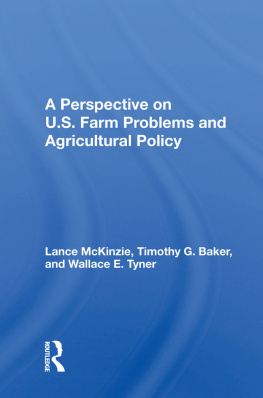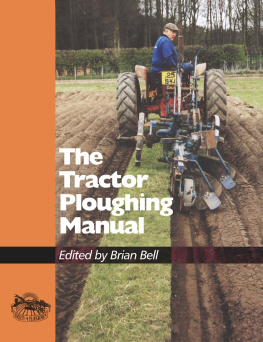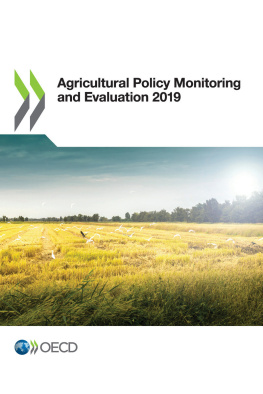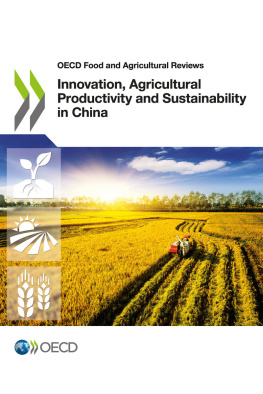A Perspective on U.S. Farm Problems and Agricultural Policy
About the Book and Authors
Today's American farmers struggle constantly with a financial crisis. News reports chronicle the dreary events foreclosures, protests, governmental debates, distress sales. There is great pressure on the U.S. government to ease the current farm financial situation, but there is opposing pressure to wean the farm sector from government support, to move agriculture toward a market-oriented economy, and above all, to reduce government outlays. Because the financial crisis permeates the agricultural community, critical choices must be made regarding the role of government in the farm sector, and alternate policies must be conceived.
A Perspective on U.S. Farm Problems and Agricultural Policy provides a framework for evaluating national policy alternatives and attempts to improve our understanding of the nature of the farm sector and its problems. The discussion covers important issues such as farm size, the process of dynamic adjustment to changing technology, and financial disruptions associated with periodic land booms and busts. The issues are presented in historical perspective and in relation to past agricultural policies.
The authors move to more specific examination of the current financial crisis by looking at various sizes and types of midwest farms. They establish different categories of financial stress in the context of both historical data for the national farm sector and more recent data on individual farms, drawing conclusions about the primary determinants of financial stress and the manner in which individuals are adjusting to it.
Lance McKinzie is currently an analyst with the State Utility Forecasting group in the Department of Agricultural Economics at Purdue University. Timothy G. Baker is an associate professor of agricultural economics at Purdue University. Wallace E. Tyner is a professor of agricultural economics at the same institution.
A Perspective on U.S. Farm Problems and Agricultural Policy
Lance McKinzie, Timothy G. Baker, and Wallace E. Tyner
First published 1987 by Westview Press, Inc.
Published 2018 by Routledge
52 Vanderbilt Avenue, New York, NY 10017
2 Park Square, Milton Park, Abingdon, Oxon OX14 4RN
Routledge is an imprint of the Taylor & Francis Group, an informa business
Copyright 1987 Taylor & Francis
All rights reserved. No part of this book may be reprinted or reproduced or utilised in any form or by any electronic, mechanical, or other means, now known or hereafter invented, including photocopying and recording, or in any information storage or retrieval system, without permission in writing from the publishers.
Notice:
Product or corporate names may be trademarks or registered trademarks, and are used only for identification and explanation without intent to infringe.
Library of Congress Catalog Card Number: 86-051501
ISBN 13: 978-0-367-01387-5 (hbk)
The nation now faces critical choices regarding the role which government can and should play in the farm sector. There is great pressure for our government to act to ease the current farm financial situation. There is also great pressure to wean the farm sector from government support, to move agriculture toward a market oriented economy, and above all to reduce government outlays. The purpose of this book is to provide a perspective for evaluation of these choices.
This book represents an attempt to improve our understanding of the nature of the farm sector, its problems and national policy alternatives. Important issues such as farm size, the process of dynamic adjustment to changing technology and financial disruptions associated with periodic land booms and busts are covered. These issues are presented in an historical perspective and in relation to past agricultural policies.
The book also provides an In-depth view of the current financial crisis situation on different sizes and types of midwest farms. Different categories of financial stress are explained in the context of historical data for the national farm sector and of more recent data on individual farms. Conclusions are drawn about the primary determinants of financial stress and the manner in which individuals are adjusting to this stress.
A fundamental problem with the farm sector is defined in the book as the condition responsible for the trauma which must be endured each time beliefs about the level of future returns to farm assets are changed and substantially lower returns are expected. The problem occurs in the aftermath of each land boom. The effect of this change in beliefs is a large transfer of wealth to future consumers of agricultural outputs and from current owners of farm assets. That transfer results in great trauma, first because it is quite concentrated on farmers and second because necessary adjustments are further concentrated among those farmers with substantial debt financing.
Traditional commodity programs do not make the farm sector more resilient in the face of changes in beliefs about farm returns nor do traditional credit programs. It is argued in this book that policy approaches capable of ameliorating this problem must encourage more equity financing and less debt financing or provide means whereby debt financing can be made more acceptable. The latter alternative is explored in detail.
A policy proposal is made with the objective of developing institutions which provide opportunity for individuals to transfer the risk associated with debt financing of farm assets to other individuals willing and able to accept that risk. The proposal provides both short- and long-term benefits to the sector:
- A corporate type institution would be developed to facilitate outside investment in farm assets.
- Current farm asset values would be supported as the above institution was initiated.
- A futures exchange for "stock in the above institution would allow for transferring the risk associated with holding farm assets (especially those financed with debt).
Lance MoKinzie
Timothy G. Baker
Wallace E. Tyner
Research behind the book and its writing was supported by the USDA through a cooperative agreement with Purdue University. The idea for broadening traditional patterns of food and agricultural policy research stemmed from a conversation several years ago in Logan, Utah, with Dr. Kenneth Clayton, who is now Director of the National Economic Division of ERS. Ken felt strongly about the need to view farm policy research in a time frame longer than that fostered by the four-year farm bills. So much research effort has been devoted in the past to preparing for debate on the "next" farm bill that research seemed all too confined to fussing with details of traditional commodity programs. New thinking on old farm problems was "too" infrequent. We were excited about searching for new approaches. The cooperative agreement, several working papers, and this book are the outcome.
Keith Schap, a freelance writer, performed something of magic on our first draft. He went over the entire manuscript, changing a word here and rewriting a section there, managing to greatly clarify our treatise and often our own thinking without distorting our original meanings. Keith is a fine writer. Tana Taylor, Jeri McIntyre, and Dixie Strubel shared orchestration of the word processing.









